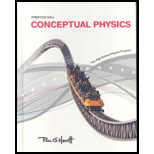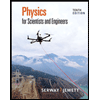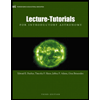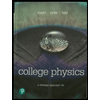
Concept explainers
Stephen uses his cell phone to talk to Fiona, who is reading downstairs, 12 meters away. The phone signal leaves Stephen’s phone, travels 6.0 km to a cell tower, and then is immediately sent to Fiona’s phone. When Stephen speaks, how long does the signal take to get from his phone to Fiona’s phone? How does this time compare with the time it would take for the sound to travel to Fiona if Stephen instead just yelled downstairs?
To Calculate: The time taken by the signal to reach from person S’s phone to person F’s phone via cell tower and time for the sound to travel to person F directly.
Answer to Problem 65A
The cell phone signal is 875 times faster.
Explanation of Solution
Given info:
The distance between the cell phone and cell tower is 6 km
Distance between the cell phone and person F is 12 m
Formula used:
Here, t is the time, d is the distance and v is the speed.
Calculation:
Time taken by the cell phone signals:
Signal goes from phone to tower and then tower to phone. So, distance travelled will be doubled.
Here, distance from phone to tower is
And the speed of light is
Then,
Speed of sound =
Time taken by the sound,
So,
Conclusion:
The cell phone signal is 875 times faster.
Chapter 27 Solutions
Conceptual Physics: The High School Physics Program
Additional Science Textbook Solutions
Chemistry: Structure and Properties (2nd Edition)
Applications and Investigations in Earth Science (9th Edition)
Campbell Biology (11th Edition)
Biology: Life on Earth (11th Edition)
Campbell Essential Biology (7th Edition)
Genetic Analysis: An Integrated Approach (3rd Edition)
- Answer the assignment 1 question and show step-by-step solution. This is from Chapter 7 from the book, "The Essential Cosmic Perspective" 8th edition by Bennett, Donahue, Schneider, Voit. I provided some helpful notes to help with the solution.arrow_forwardAnswer the assignment 2 question and show step-by-step solution. This is from Chapter 7 from the book, "The Essential Cosmic Perspective" 8th edition by Bennett, Donahue, Schneider, Voit. I provided some helpful notes to help with the solution.arrow_forwardA cyclic process for an ideal gas is shown. The cycle has three stages: isovolumetric, adiabatic. and isothermal. Work is done on the gas during the isothermal stage. Pressure Stage Z Stage Y Which stage is isothermal and what is the direction of the cyclic process? Stage Direction A B C D A. Y B. Z C. Y N Anti-clockwise Anti-clockwise Clockwise Clockwise Volumearrow_forward
- I need help with this matching question from an Astronomy assignment. Please provide me with the correct answers and explain it to me.arrow_forwardAnswer the assignment 2 question and show step-by-step solution. This is from Chapter 6 from the book, "The Essential Cosmic Perspective" 8th edition by Bennett, Donahue, Schneider, Voit. I provided some helpful notes to help with the solution.arrow_forwardAnswer the assignment 1 question and show step-by-step solution. This is from Chapter 6 from the book, "The Essential Cosmic Perspective" 8th edition by Bennett, Donahue, Schneider, Voit. I provided some helpful notes to help with the solution.arrow_forward
- Pls help ASAP on botharrow_forwardQuestion 16 A square plate has a side length of 1.20m. A 24.0- N'm torque is applied about an axis perpendicular to the plate through its centre. If it experiences an angular acceleration of 6.25rad/s², calculate the mass of the plate. Question 17 A light string is wrapped around a solid cylinder, and a block of mass m = 100g hangs from the free end of the string, as shown Figure A2.17. When released, the block falls a distance of 1.0m in 2.0s. a. Draw free-body (or force) diagrams for the block and the cylinder. b. Calculate the tension in the string. c. Determine the mass (M) of the cylinder.arrow_forwardPls help ASAP on botharrow_forward
- Pls help ASAP on botharrow_forwardQuestion 7 A box slides on a smooth (frictionless) horizontal surface, 1.5m above the floor, at a speed of 2.0m/s, as shown in Figure A2.07. The box then slides down a ramp that makes an angle of 36° with the horizontal and has a coefficient of kinetic friction equal to 0.43. After reaching the end of the ramp, the box continues to slide horizontally on the smooth floor. Use the law of conservation of energy to calculate the final speed (v) of the box.arrow_forwardQuestion 3 Three lead spheres, of mass 10kg each, are located at three corners of a square of side length 45cm, as shown in Figure A2.03. A bead is released at the forth corner. By considering the gravitational forces among the four objects only, determine the magnitude and direction of the acceleration of the bead when released.arrow_forward
 College PhysicsPhysicsISBN:9781305952300Author:Raymond A. Serway, Chris VuillePublisher:Cengage Learning
College PhysicsPhysicsISBN:9781305952300Author:Raymond A. Serway, Chris VuillePublisher:Cengage Learning University Physics (14th Edition)PhysicsISBN:9780133969290Author:Hugh D. Young, Roger A. FreedmanPublisher:PEARSON
University Physics (14th Edition)PhysicsISBN:9780133969290Author:Hugh D. Young, Roger A. FreedmanPublisher:PEARSON Introduction To Quantum MechanicsPhysicsISBN:9781107189638Author:Griffiths, David J., Schroeter, Darrell F.Publisher:Cambridge University Press
Introduction To Quantum MechanicsPhysicsISBN:9781107189638Author:Griffiths, David J., Schroeter, Darrell F.Publisher:Cambridge University Press Physics for Scientists and EngineersPhysicsISBN:9781337553278Author:Raymond A. Serway, John W. JewettPublisher:Cengage Learning
Physics for Scientists and EngineersPhysicsISBN:9781337553278Author:Raymond A. Serway, John W. JewettPublisher:Cengage Learning Lecture- Tutorials for Introductory AstronomyPhysicsISBN:9780321820464Author:Edward E. Prather, Tim P. Slater, Jeff P. Adams, Gina BrissendenPublisher:Addison-Wesley
Lecture- Tutorials for Introductory AstronomyPhysicsISBN:9780321820464Author:Edward E. Prather, Tim P. Slater, Jeff P. Adams, Gina BrissendenPublisher:Addison-Wesley College Physics: A Strategic Approach (4th Editio...PhysicsISBN:9780134609034Author:Randall D. Knight (Professor Emeritus), Brian Jones, Stuart FieldPublisher:PEARSON
College Physics: A Strategic Approach (4th Editio...PhysicsISBN:9780134609034Author:Randall D. Knight (Professor Emeritus), Brian Jones, Stuart FieldPublisher:PEARSON





